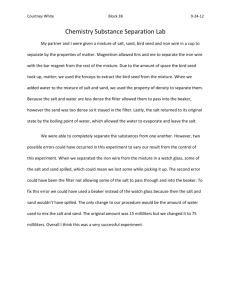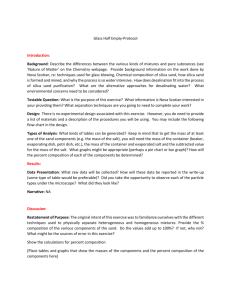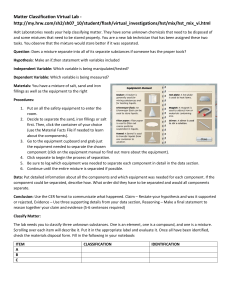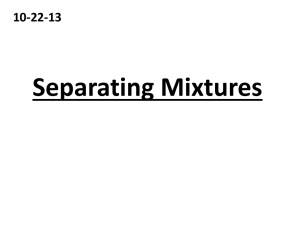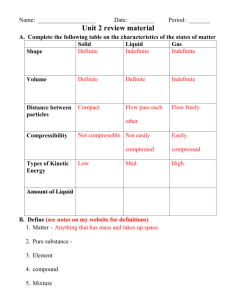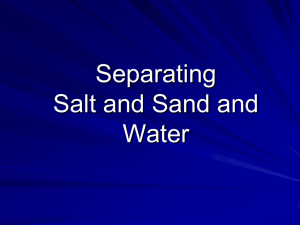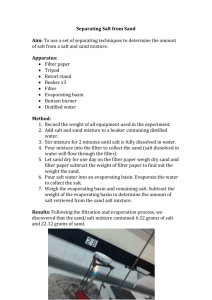CHM HOT Lab
advertisement
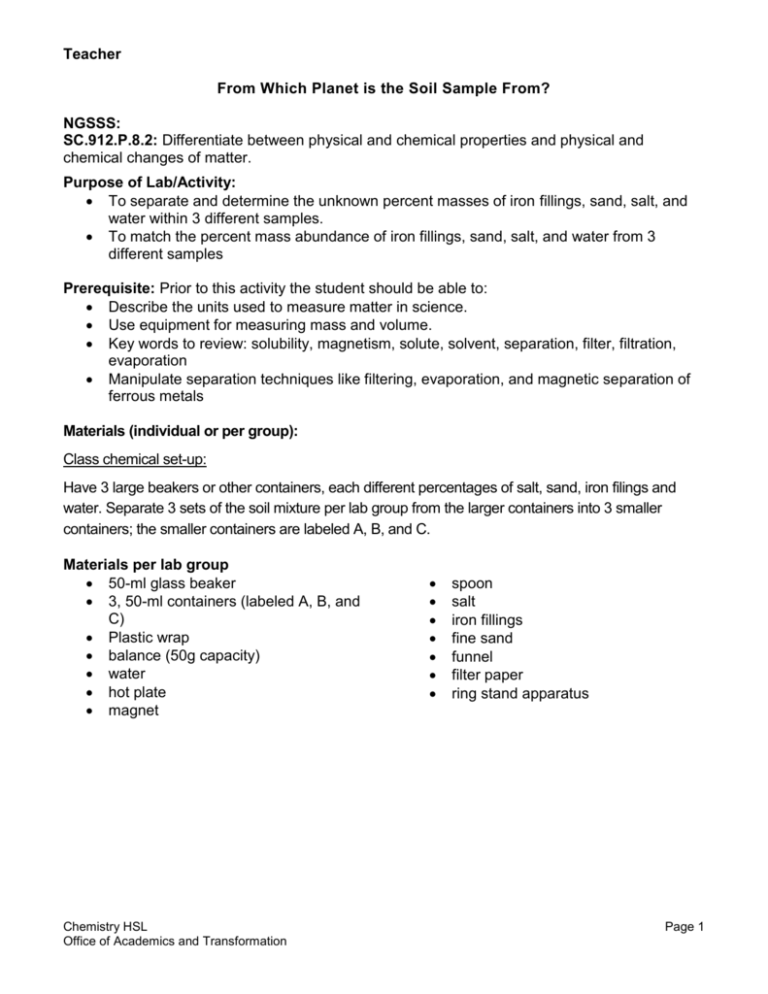
Teacher From Which Planet is the Soil Sample From? NGSSS: SC.912.P.8.2: Differentiate between physical and chemical properties and physical and chemical changes of matter. Purpose of Lab/Activity: To separate and determine the unknown percent masses of iron fillings, sand, salt, and water within 3 different samples. To match the percent mass abundance of iron fillings, sand, salt, and water from 3 different samples Prerequisite: Prior to this activity the student should be able to: Describe the units used to measure matter in science. Use equipment for measuring mass and volume. Key words to review: solubility, magnetism, solute, solvent, separation, filter, filtration, evaporation Manipulate separation techniques like filtering, evaporation, and magnetic separation of ferrous metals Materials (individual or per group): Class chemical set-up: Have 3 large beakers or other containers, each different percentages of salt, sand, iron filings and water. Separate 3 sets of the soil mixture per lab group from the larger containers into 3 smaller containers; the smaller containers are labeled A, B, and C. Materials per lab group 50-ml glass beaker 3, 50-ml containers (labeled A, B, and C) Plastic wrap balance (50g capacity) water hot plate magnet Chemistry HSL Office of Academics and Transformation spoon salt iron fillings fine sand funnel filter paper ring stand apparatus Page 1 Teacher Procedures: Day of Activity What the teacher will do: a. Set up the 3 soil samples so that each beaker contains the following: Sample A has (compared to samples B and C) a relatively small amount of sand, a relatively medium amount of iron fillings and relatively large amount of salt. Sample B, has a medium (relatively) amount of sand, a relatively large amount of iron fillings and a relatively small amount of salt. b. Before activity: c. d. e. f. g. During activity: Sample C has a relatively large amount of sand, a small amount of iron fillings and medium amount of salt. Fill the water level of each beaker that contains the 3 samples to approximately the same height. Define the following terms with the class: mass, extracting, filtering, magnetism, evaporation, mixture, percent abundance. Ask the students if they have any idea how salt could be obtained from sea water? Ask students what property could be used to detect if an object is made of steel or iron versus another material? Demonstrate how to perform the following techniques associated with each term: Measuring mass, extracting, filtering, evaporating the liquid so that a solid remains, magnetic removal of substances that are attracted to magnets. Have the lab equipment ready to use for each lab group. State the intent of the lab: To separate the contents (sand, salt, iron, water) of the 3 different mixtures by visualizing the steps needed and utilizing the equipment provided. A secondary intent is to match the percent mass of the contents of each mixture with given percent mass values written on the board. Review or teach the concept of percent mass. Demonstrate how to do a calculation demonstrating percent mass. What the teacher will do: a. Monitor that students are using the instruments to separate the iron from the sand, separate the sand from the salty water, and then separate the water from the salt. b. As you visit each group, make sure that they are proceeding at a good pace. It is important to correct if you determine that a group is progressing in the wrong direction in analyzing the samples. c. Tips: The saran wrap can be used to wrap around the magnet to extract the filings. When removed from the magnet, the filings will drop off the wrap easily. Some students may not realize this and use the magnet without the wrap—it will work fine, but they will have to scrap the filings off, taking more time. Many students will use techniques out of the most logical order—they will evaporate the water before filtering the sand. d. Ask students to calculate the percent mass for each of the 3 samples of salt, sand, iron and water. e. Match student Samples A, B, and C with data corresponding to soils from different “planets”. Chemistry HSL Office of Academics and Transformation Page 2 Teacher After activity: What the teacher will do: a. Have students share their lab group data with the whole class. b. Have students orally explain their thought process in determining the order of the procedures that they did to separate the each of the mixtures. c. Lead a discussion to try to explain the differences in the values reported by each group. Introduce the concept of random variation in measurements caused by different students measuring the same quantity with different equipment. d. Have students describe multiple sources of error and what they could have done to minimize the errors. Chemistry HSL Office of Academics and Transformation Page 3 Student From Which Planet is the Soil Sample From? NGSSS: SC.912.P.8.2: Differentiate between physical and chemical properties and physical and chemical changes of matter. Background: Mixtures are not unique to chemistry; you use and consume them on a daily basis. The beverages you drink each morning, the fuel you use in your automobile, and the ground you walk on are mixtures. Very few materials that you encounter are pure. Any material made up of two or more substances that are not chemically combined is a mixture. The isolation of pure components of a mixture requires the separation of one component from another. Techniques needed to do this separation take advantage of the differences in physical properties of the components. The techniques you will use in this lab include the following: 1. Magnetic separation: A process in which magnetically susceptible material is extracted from a mixture using a magnetic force. This separation technique can be useful in mining iron as it is attracted to a magnet. 2. Extraction: This uses a solvent to selectively dissolve one component of the solid mixture. With this technique, a soluble solid can be separated from an insoluble solid. 3. Decantation: This separates a liquid from an insoluble solid by carefully pouring the liquid from the solid without disturbing the solid. 4. Filtration: This separates a solid from a liquid through the use of a porous material as a filter. Paper is a good filter. Filters allow the liquid to, pass through but not the solid. 5. Evaporation: This is the process of heating a mixture in order to drive off a volatile liquid and make the remaining component dry. The mixture that will be separated in this lab contains four components: water, common table salt, NaCl, sand, SiO2 and iron fillings, Fe . The separation will be done according to a student created scheme for the procedures but will involve three separation techniques: 1. Magnetic separation. 2. Extraction, decantation and filtration. 3. Evaporation Chemistry HSL Office of Academics and Transformation Page 4 Student Purpose of Lab/Activity: To separate and determine the unknown masses of iron fillings, sand, salt and water present mass within 3 different samples. To match the percent mass abundance of iron fillings, sand, salt, and water from 3 different samples Prerequisite: Prior to this activity the student should be able to: Describe the units used to measure matter in science. Use equipment for measuring mass and volume. Key words to review: solubility, magnetism, solute, solvent, separation, filter, extraction, filtration, evaporation Manipulate separation techniques like extraction, filtering, evaporation, and magnetic removal of ferrous metals Materials (individual or per group): Class chemical set-up: Have 3 large beakers or other containers, each with different percentages of salt, sand, iron filings and water. Separate 3 sets per lab group of smaller containers labeled A, B, and C that will contain each of 3 different mixtures. Materials per lab group 50-ml glass beaker 3, 50-ml containers Plastic wrap balance (50g capacity) water hot plate magnet spoon salt iron fillings fine sand funnel filter paper ring stand apparatus Chemistry HSL Office of Academics and Transformation Page 5 Student Safety: Always wear safety goggles in the lab. Vocabulary: mass, filtering, magnetic separation, decanting, extraction, evaporation, mixture, percent abundance. Procedures (Possible): 1. Demonstrate how to perform the following techniques associated with each term: Measure mass, extraction, filtering, evaporating the liquid so that a solid remains, magnetic removal of substances that are attracted to magnets. 2. Ensure that all lab equipment is ready for use. 3. Take the mass of beaker plus the soil sample. 4. Wrap the magnet with saran wrap. Stir the mixture with the wrapped magnet until all the iron filings have been collected 5. Remove the wrap from the magnet, being careful to keep all the iron filings in the wrap. 6. Set up a filtration station: Fold filter paper into fourths, place in the funnel and wet down. Place funnel in ceramic triangle on ring on ring stand (or in funnel rack). Place an empty beaker underneath the funnel, with funnel tip inside and touching the side of the beaker. 7. Decant the mixture down the stirring rod into the funnel. 8. Remove the filter paper with the sand from the funnel and lay flat on a paper towel to dry. 9. Place the beaker containing the filtrate (water and salt) on the hot plate (or Bunsen burner setup). Heat until near dryness. Remove beaker from heat source—using caution with hot glassware—and allow the heat in the glass to finish the drying. 10. Place all components of the mixture in areas designated by the teacher to take the mass of each. 11. Calculate the percent mass for each of the 3 samples of salt, sand, iron and water. 12. Match student Samples A, B, and C with data corresponding to soils from different “planets” posted on the board. Observations/Data: Data for Sample A Percent mass of salt, sand, iron and water in Sample A Mass of sample + container (g) Mass of container (g) Mass of sample A Mass of water (g) Percent water in entire sample (%) Mass of salt (g) Percent salt in entire sample (%) Mass of sand (g) Percent sand in entire sample (%) Mass of iron (g) Percent iron in entire sample (%) Qualitative Description: Describe how does Sample A compares to Sample B and Sample C (use as many descriptive words as you can).___________________________________________________________________________ _______________________________________________________________________________ Chemistry HSL Office of Academics and Transformation Page 6 Student Data for Sample B Percent mass of salt, sand, iron and water in Sample B Mass of sample + container (g) Mass of container (g) Mass of sample A Mass of water (g) Percent water in entire sample (%) Mass of salt (g) Percent salt in entire sample (%) Mass of sand (g) Percent sand in entire sample (%) Mass of iron (g) Percent iron in entire sample (%) Qualitative Description: Describe how does Sample B compares to the other samples:_____________________________________________________________________ ____________________________________________________________________________ Data for Sample C Percent mass of salt, sand, iron and water in Sample C Mass of sample + container (g) Mass of container (g) Mass of sample A Mass of water (g) Percent water in entire sample (%) Mass of salt (g) Percent salt in entire sample (%) Mass of sand (g) Percent sand in entire sample (%) Mass of iron (g) Percent iron in entire sample (%) Qualitative Description: Describe how does Sample C compares to the other samples:_____________________________________________________________________ ____________________________________________________________________________ Observation/Data Analysis: 1. 2. 3. 4. 5. 6. 7. 8. 9. Why can sand and salt be separated using this experiment? Why is the salt, sand and water mixture filtered? Why is the salt solution heated? How might the final traces of water be removed from your samples to ensure that they’re totally dry? Give two reasons why the sand you have obtained might still be contaminated with salt. Describe the technique that your team used to remove the iron from the mixture. How could you adapt your experiment to obtain a purer sample of sand? Give two reasons why the salt you have obtained might still be contaminated with sand. How could you adapt your experiment to obtain a purer sample of salt? Chemistry HSL Office of Academics and Transformation Page 7 Student Conclusion: 1. 2. 3. 4. 5. Describe in your own words the procedures used to separate each substance from the mixture. How well did each procedure work? What would you change next time? Why? What did this lab teach you about mixtures? List and describe at least 2 sources of error and then describe how you could reduce these errors. Chemistry HSL Office of Academics and Transformation Page 8

